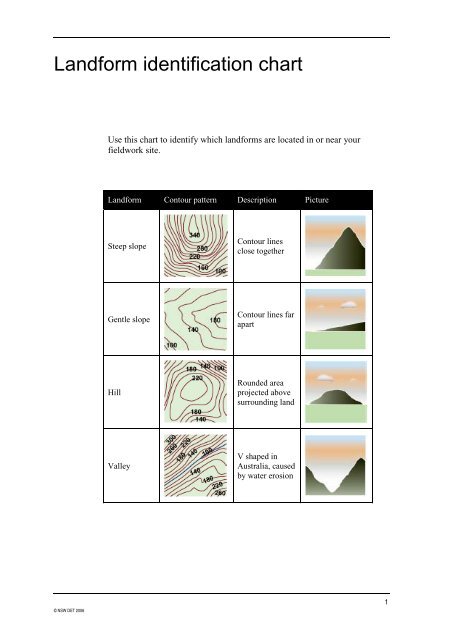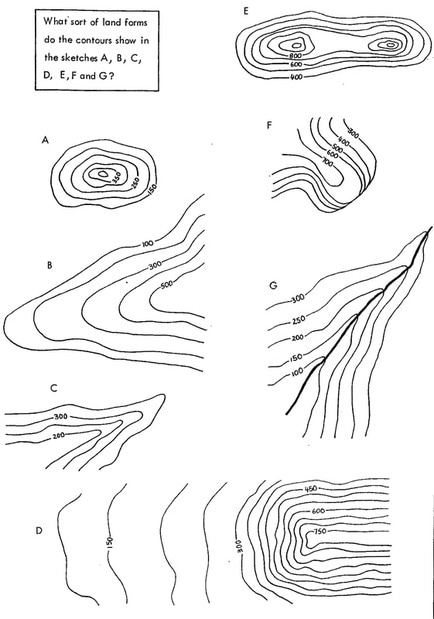Using the basic principles of slope shape and altitude it is possible to identify a wide range of physical landforms on maps. Essentially topographic maps represent the three-dimensional landscape of Earth within the two-dimensional space of a map.
Recognising Landforms Year 8 Geography
Lines form a V pattern along valleys.

. U-shaped contours indicate broader ridges while V-shaped contours represent narrower and sharper ridge lines. Reading contour patterns on a topographic map. A contour line represents an imaginary line on the ground above or below sea level.
They join together places of the same height and form patterns that help us to imagine what the land actually looks like. Contour lines form a U or V shape that points away from the high land. Other features are shown by a variety of conventional signs symbols lines and patterns which are printed in appropriate colors and identified by names labels and numbers.
Contour patterns can be used to recognise distinctive landforms such as ridges valleys and hills contours may appear as black or coloured lines on maps and are often supported by colour shading to give an impression of relief cross-sections provide a useful way of visualizing the shape of the land surface but care needs to be define. Contour lines evenly spaced and wide apart indicate a uniform gentle slope Uniform steep slope. Contour lines are drawn in intervals.
It is possible to use them to see the shape of the land - if contour lines. A basic skill that landscape architects and site designers must develop is the ability to analyze interpret and visualize landforms from contour maps and plans commonly referred to as topo-graphic maps. Low land between hills or mountains.
Streamsalways flow downhill Contours can and do cross streams. An area of land that sticks out like a finger from the side of a mountain or hill. Aretes and spurs are often generally referred to as ridges in backcountry recreation.
Landforms and terrain features such as mountain pass col or saddle cliff and depression are represented by contour lines in topographic maps. Contour lines closely spaced at the top and widely spaced at the bottom in-. Ally represent elevations and laNdforms--the shapes into which the earths surface is sculp tured by natural forces--by contour lines.
All points on a contour line are at the same elevation. Indicating the direction of the stream flow. Standard colors for contour lines are brown red or black.
Valleys are represented by V- shaped contour lines with the apex of the V- shape pointing towards the highland. Ridges are represented by U or V shaped contour lines with their closed end pointing towards lower elevation. The following are three types of con- tour lines.
The difference in height between each contour line is called the contour intervalthe patterns created by contour lines makes some landforms easily identifiable because each landform feature has quite a distinctive lookyou need to be familiar with a few key contour patterns such as hills valleys saddles streams and cliffs so you can interpret. The closer the contour lines are to each other the steeper the slope Concave slope. LANDFORMS The way in which contour lines are arranged allows us to identify certain landforms and features in the terrain.
Designers must not only under-. Topographic maps use a combination of colors shading and contour lines to represent changes in elevation and terrain shape. Contour Representation of Landforms.
Contour lines evenly spaced and close together indicate a uni-form steep slope. Are lowland between two highlands. The following are some common landforms or relief features that can be represented on map by using contour lines.
They are usually an orange or brown colour. Geography SS 2 Week 2. Contour patterns can be used to recognise distinctive landforms such as ridges valleys and hills Contours may appear as black or coloured lines on maps and are often supported by colour shading to give an impression of relief Cross-sections provide a useful way of visualizing the shape of the land surface but care needs to be.
Con- tour lines never cross one another. Here that contour drawings are two-dimensional representations of three-dimensional forms. Some contour lines have their height above or below sea level written on them.
Part 2 - Map interpretation Contour patterns can be used to recognise distinctive landforms such as ridges valleys and hills Contours may appear as black or coloured lines on maps and are often supported by colour shading to give an impression of relief Cross-sections provide a useful way of visualizing Topographic maps illustrate the shape of the Earths surface and help. The contour lines join up areas of the same height and when they are close together it means the hill or mountain is steep. A map with contour lines on it is called a topographic map.
Contour lines are the main way the map maker shows the map reader the height slope of the land on a flat piece of paper. When they are far apart it means the land is gently sloping or undulating. Contour lines are a maps way of showing you how high the land is.

Countour Lines Matching Game Teaching Geography Geography For Kids Geology

Topographic Maps Contour Lines And Landforms Diagram Quizlet

Topographical Maps Contour Lines Ppt Download

Using Contours To Identify Landforms Youtube

Exemplary Clusters Of Closed Contour Lines Show Isolated Hill A Download Scientific Diagram

Contour Geography Geomorphology Part 3 Applied Geography Facebook


0 comments
Post a Comment